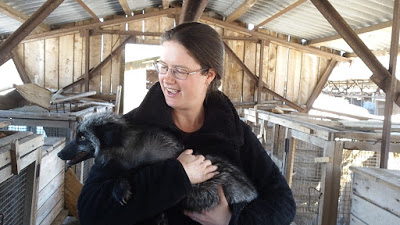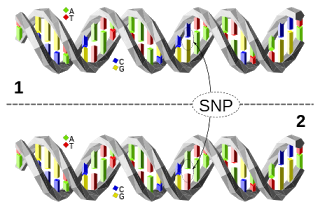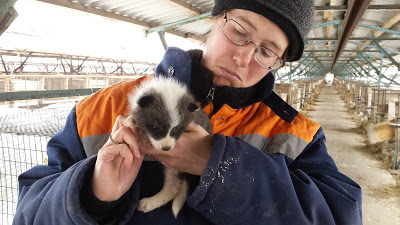Dogs
Guest post by: Dr Jessica Perry Hekman DVM MS
Hi Mia and Julie,
One of the things I love most about dogs is how friendly they are. What's the biggest difference between a dog and a wolf? The dog probably wants to come say hi to you. The wolf is scared of you, and may demonstrate that fear through aggression if you get too close.
But not ALL dogs are friendly, right? If “friendliness” versus “fear” was on a spectrum, most dogs would be on the “friendly” end, but some would be down towards the “fear” end with the wolves. This is what I study: what is going on in the brain of fearful dogs to make them scared of things? What are the mechanisms that are different? I'm interested in the wiring in the brain, hormone differences, neurotransmitter differences, and more.
Right now, the way I'm studying fear in dogs is by studying fear in foxes. I know you know about the famous population of tame foxes at the Institute of Cytology and Genetics in Novosibirsk, Russia. I got to go meet these foxes recently!
They have been bred for tameness for more than forty generations, and are a lot like dogs in their friendliness and lack of fear. In the lab where I work, we compare these foxes to another group of foxes that have been selected for fearfulness/aggression. Through comparing these very different groups, we to try to understand the biological mechanisms behind their personality differences. Foxes are evolutionarily close to dogs, and because these foxes have carefully controlled genetics and environments, they are easier to study than pet dogs are. (I still hope to transition to working directly with pet dogs some day, though.)
Over the years, much has been learned about the tame foxes: their stress response is very different from that of the aggressive foxes [1]; they have different levels of various neurotransmitters in their brains [1], and they even have differences in brain structure [2]. In the lab where I work, Kukekova Lab at the University of Illinois at Urbana-Champaign, we study the genetic differences between these groups of foxes. We hope that finding differences in their genes will help us learn more about mechanistic differences in their brains. Our lab recently published a new paper in PLoSONE [3] about some of our findings.
We are still very much at the stage of just trying to figure out where in the enormous genome (3.3 billion nucleotides!) the personality differences between tame and aggressive foxes come from. (By the way, various efforts looking at personality differences in humans are at the same stage.)
Our lab's approach in this paper was to look at the entire genomes of 40 foxes, 20 tame and 20 aggressive. First we found the places in their genomes in which at least one fox was different at the level of just one nucleotide. A single nucleotide differences is known as a single nucleotide polymorphism, or SNP. Unfortunately, while a SNP might be a pointer to an important difference, most SNPs mean absolutely nothing. The problem is telling which is which. And we found thousands of them – more than 100,000 of them, which we filtered down to 8,437 of them that we actually wanted to use. So how would we figure out which ones were pointing at real and important differences in the tame fox genome?
To answer this question, we looked for differences not just between individual foxes, but between the group of 20 tame foxes and the group of 20 aggressive foxes. With 8,437 SNPs you had better bet we used computers for this. It was a surprise to me when I got into modern genomics just how much of the work deals with complex computer algorithms to process the massive amounts of data we're dealing with!
We found several areas of the fox genome in which tame foxes tended to have one version of some SNPs, while aggressive foxes tended to have another version. To understand this, it can help to think of the genome as a big instruction manual, a book called “How to Build a Fox.” Mostly the instruction manuals for tame and aggressive foxes would be the same, but in a few cases single letters would be different.
Imagine that the tame foxes all had, “The quick brown fox jumps over the lazy dog” in their version of chapter two, but the aggressive foxes all had, “The quick brown fox jumps over the lazy doc” in their version. Basically, by finding places where the tame foxes all had one version, and the aggressive foxes all had a different version, we were finding places in the genome where we hoped to find important differences, changes that help cause the tame fox personality phenotype. We found 28 regions like this, but focused on three of them as the most interesting.
Next we looked at the genes that these changes might affect, because finding gene differences was the point of the whole exercise. Remember, we still don't know most of what most of the genes out there do! This is really dark side of the moon stuff, and everyone is still guessing about what's going on in the genome, human or fox. But here are some interesting genes we found. I'm including a “wild hypothesis” with some of them. These hypotheses are probably wrong, but I hope they help to show why these genes are so interesting to us...
GRIN2B: this gene codes for a receptor for one of the major neurotransmitters in the brain, glutamate. Glutamate is involved in learning and memory. Wild hypothesis: maybe tame foxes are less afraid because of a difference in how they learn about what to fear.
GABARAPL1 (GEC1): this gene is involved with opioids, molecules in the brain that help us feel good. Wild hypothesis: maybe tame foxes are more friendly because social interactions feel different (better) to them.
COUP-TFII (NR2F2): this gene is important during embryonic brain development, especially in the amygdala, a part of the brain that tells us when to be afraid. This gene also influences expression of oxytocin, a neurotransmitter which functions in social bonding.
These genes are extremely interesting, but even more than that, this work helped our lab implicate specific regions of the genome in the differences between tame and aggressive foxes. That list of regions will prove invaluable as we do more work in the future, using different tools to examine the tame fox genome and seeing which tools point at the same regions.
Tame fox kisses to you both!
Jessica
Dr. Jessica Perry Hekman graduated Tufts Cummings School of Veterinary Medicine in 2012, where in addition to her DVM she received an MS for work on stress behavior and cortisol levels in hospitalized dogs. She completed a shelter medicine internship at the University of Florida in 2013, and is now a PhD student at the University of Illinois at Urbana-Champaign, where she works at Kukekova Lab. Her research interests are in the biological mechanisms behind fearfulness in dogs. You can follow her at @dogzombieblog.
Images copyright Jessica Hekman.
[1] Trut, Lyudmila N., I. Z. Plyusnina, and I. N. Oskina. "An experiment on fox domestication and debatable issues of evolution of the dog." Russian Journal of Genetics 40.6 (2004): 644-655.
[2] Huang, Shihhui, et al. "Selection for tameness, a key behavioral trait of domestication, increases adult hippocampal neurogenesis in foxes." Hippocampus (March 2015).
[3] Johnson, Jennifer L. et al. "Genotyping-By-Sequencing (GBS) Detects Genetic Structure and Confirms Behavioral QTL in Tame and Aggressive Foxes (Vulpes vulpes)." PLoSONE (2015).
© 2015 Jessica Perry Hekman | Do You Believe in Dog?
- The Science Of How Behavior Is Inherited In Aggressive Dogs By Alexandra Semyonova
From Animals 24-7 Probably most people recognize that every dog breed results from human manipulation of inherited physical traits. Until recently, most people probably also recognized that much...
- Why Did Dogs Become Our Best Friends?
By Linda Cole No one really knows exactly how dogs were domesticated, although there is evidence pointing towards a mutual benefit for both man and canine. “Why” dogs became our best friend has been more elusive. However, research into dog behavior...
- The Canine Behavior Studies Of Dr. Udell
By Linda Cole I'm always interested in reading new studies done about dogs that help us better understand our relationship with them. Dr. Monique Udell is someone who has her name attached to many of these studies. One recent study conducted by Dr....
- Rabies In Dogs
Rabies elicits fear in one and all, and very rightly so. It is one of the most dreaded dog illnesses, as there is no cure or treatment for this disease that is caused by a deadly virus. This virus is shed with the saliva of an infected animal. When...
- List Of Exotic Pets
My Pet is Cooler Than Your Pet...List Of Exotic Pets To ConsiderI've always been attracted to exotic pets. Why not? They're unique, they display qualities you won't find in more common pet species, and they'll wow your friends. However,...
Dogs
Understanding the Tame Fox: The Hunt for the Genetic Mechanisms of Fearfulness
 |
| Jessica Hekman meets friendly fox. |
Hi Mia and Julie,
One of the things I love most about dogs is how friendly they are. What's the biggest difference between a dog and a wolf? The dog probably wants to come say hi to you. The wolf is scared of you, and may demonstrate that fear through aggression if you get too close.
But not ALL dogs are friendly, right? If “friendliness” versus “fear” was on a spectrum, most dogs would be on the “friendly” end, but some would be down towards the “fear” end with the wolves. This is what I study: what is going on in the brain of fearful dogs to make them scared of things? What are the mechanisms that are different? I'm interested in the wiring in the brain, hormone differences, neurotransmitter differences, and more.
Right now, the way I'm studying fear in dogs is by studying fear in foxes. I know you know about the famous population of tame foxes at the Institute of Cytology and Genetics in Novosibirsk, Russia. I got to go meet these foxes recently!
They have been bred for tameness for more than forty generations, and are a lot like dogs in their friendliness and lack of fear. In the lab where I work, we compare these foxes to another group of foxes that have been selected for fearfulness/aggression. Through comparing these very different groups, we to try to understand the biological mechanisms behind their personality differences. Foxes are evolutionarily close to dogs, and because these foxes have carefully controlled genetics and environments, they are easier to study than pet dogs are. (I still hope to transition to working directly with pet dogs some day, though.)
 |
| Hekman with friendly fox. |
We are still very much at the stage of just trying to figure out where in the enormous genome (3.3 billion nucleotides!) the personality differences between tame and aggressive foxes come from. (By the way, various efforts looking at personality differences in humans are at the same stage.)
 |
| Wikipedia |
To answer this question, we looked for differences not just between individual foxes, but between the group of 20 tame foxes and the group of 20 aggressive foxes. With 8,437 SNPs you had better bet we used computers for this. It was a surprise to me when I got into modern genomics just how much of the work deals with complex computer algorithms to process the massive amounts of data we're dealing with!
 |
| Hekman with fox at the Institute of Cytology and Genetics. |
Imagine that the tame foxes all had, “The quick brown fox jumps over the lazy dog” in their version of chapter two, but the aggressive foxes all had, “The quick brown fox jumps over the lazy doc” in their version. Basically, by finding places where the tame foxes all had one version, and the aggressive foxes all had a different version, we were finding places in the genome where we hoped to find important differences, changes that help cause the tame fox personality phenotype. We found 28 regions like this, but focused on three of them as the most interesting.
Next we looked at the genes that these changes might affect, because finding gene differences was the point of the whole exercise. Remember, we still don't know most of what most of the genes out there do! This is really dark side of the moon stuff, and everyone is still guessing about what's going on in the genome, human or fox. But here are some interesting genes we found. I'm including a “wild hypothesis” with some of them. These hypotheses are probably wrong, but I hope they help to show why these genes are so interesting to us...
 |
| Hand sniffing. |
GRIN2B: this gene codes for a receptor for one of the major neurotransmitters in the brain, glutamate. Glutamate is involved in learning and memory. Wild hypothesis: maybe tame foxes are less afraid because of a difference in how they learn about what to fear.
GABARAPL1 (GEC1): this gene is involved with opioids, molecules in the brain that help us feel good. Wild hypothesis: maybe tame foxes are more friendly because social interactions feel different (better) to them.
COUP-TFII (NR2F2): this gene is important during embryonic brain development, especially in the amygdala, a part of the brain that tells us when to be afraid. This gene also influences expression of oxytocin, a neurotransmitter which functions in social bonding.
These genes are extremely interesting, but even more than that, this work helped our lab implicate specific regions of the genome in the differences between tame and aggressive foxes. That list of regions will prove invaluable as we do more work in the future, using different tools to examine the tame fox genome and seeing which tools point at the same regions.
Tame fox kisses to you both!
Jessica
Dr. Jessica Perry Hekman graduated Tufts Cummings School of Veterinary Medicine in 2012, where in addition to her DVM she received an MS for work on stress behavior and cortisol levels in hospitalized dogs. She completed a shelter medicine internship at the University of Florida in 2013, and is now a PhD student at the University of Illinois at Urbana-Champaign, where she works at Kukekova Lab. Her research interests are in the biological mechanisms behind fearfulness in dogs. You can follow her at @dogzombieblog.
Images copyright Jessica Hekman.
[1] Trut, Lyudmila N., I. Z. Plyusnina, and I. N. Oskina. "An experiment on fox domestication and debatable issues of evolution of the dog." Russian Journal of Genetics 40.6 (2004): 644-655.
[2] Huang, Shihhui, et al. "Selection for tameness, a key behavioral trait of domestication, increases adult hippocampal neurogenesis in foxes." Hippocampus (March 2015).
[3] Johnson, Jennifer L. et al. "Genotyping-By-Sequencing (GBS) Detects Genetic Structure and Confirms Behavioral QTL in Tame and Aggressive Foxes (Vulpes vulpes)." PLoSONE (2015).
© 2015 Jessica Perry Hekman | Do You Believe in Dog?
- The Science Of How Behavior Is Inherited In Aggressive Dogs By Alexandra Semyonova
From Animals 24-7 Probably most people recognize that every dog breed results from human manipulation of inherited physical traits. Until recently, most people probably also recognized that much...
- Why Did Dogs Become Our Best Friends?
By Linda Cole No one really knows exactly how dogs were domesticated, although there is evidence pointing towards a mutual benefit for both man and canine. “Why” dogs became our best friend has been more elusive. However, research into dog behavior...
- The Canine Behavior Studies Of Dr. Udell
By Linda Cole I'm always interested in reading new studies done about dogs that help us better understand our relationship with them. Dr. Monique Udell is someone who has her name attached to many of these studies. One recent study conducted by Dr....
- Rabies In Dogs
Rabies elicits fear in one and all, and very rightly so. It is one of the most dreaded dog illnesses, as there is no cure or treatment for this disease that is caused by a deadly virus. This virus is shed with the saliva of an infected animal. When...
- List Of Exotic Pets
My Pet is Cooler Than Your Pet...List Of Exotic Pets To ConsiderI've always been attracted to exotic pets. Why not? They're unique, they display qualities you won't find in more common pet species, and they'll wow your friends. However,...
